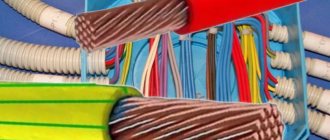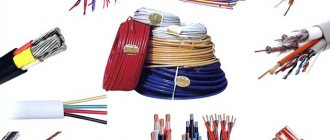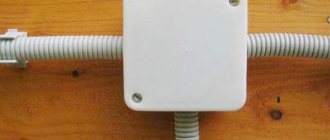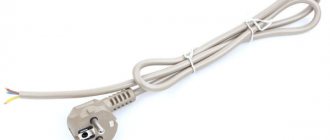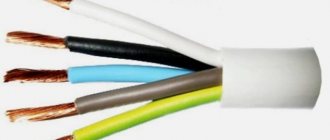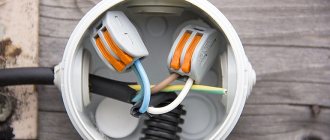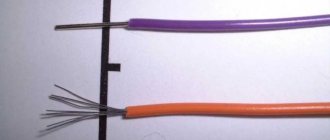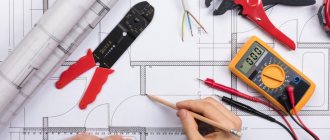Today, no home can be imagined without electrical wiring. Wires supply voltage to a variety of electrical devices that provide us with a comfortable existence.
At the same time, the number of devices may change: sometimes it is necessary to create new connection points, and for them to make new branches to supply energy.
Is it possible to create new branches in electrical wiring without cutting the wires or twisting the wires? We will talk about this in our article.
Branching with a clamp
The nut joint is often used in electrical wiring. This element can be found at the junctions of conductors in junction boxes.
The design of this element is quite simple. It consists of the following parts:
- Carbolite body;
- Steel die;
- Plates;
- Compression screws.
Thanks to all these elements, the clamp provides a durable and reliable cable branch.
This product is convenient to use for branches, since the nuts are small in size and inexpensive.
However, among the disadvantages of the connector are poor protection from moisture and the inability to make branches of live conductor cores.
You can make a connection of conductors from copper and aluminum. In addition, the cross-section of the cores can be of very different sizes, from one and a half square millimeters to one and a half square centimeters.
To do this, you need to place the wires in the die. After this, the screws are tightened with a screwdriver and the housing is snapped into place. Even a novice electrician can make a connection this way.
Coupler OV-2 47523
Purpose, application: Making parallel branches and connections from stranded and solid copper wires with sections from 1.5 to 2.5 mm²
Certification
- Certificate of Conformity for Insulated End Caps 2018 (EAC)
- Designed to make parallel branches and connections from stranded and solid copper wires
- Body material: polypropylene. Halogen free
- Insulation temperature resistance: 105 °C
- Contact part material: L63 brass
- Contact part coating: electrolytic tinning
- Does not require stripping the insulation from the main and branch wires
- Simultaneous puncture of insulation on the main and branch occurs when the housing cover is snapped into place
- Robust plastic housing provides complete insulation and mechanical protection of the branch point
- A uniform color coding system facilitates identification of dimensions during installation
- During installation, it is recommended to use pliers
➔Operational characteristics (years)
- Guaranteed shelf life: 5
- Warranty period: 5
- Service life: 25
Piercing type parallel couplers 47523
- Connector type: tap;
- Operating voltage, up to: 0.4;
- Core material: copper;
- Core cross-section, mm²: 1.5; 2.5;
- Core flexibility class: 3; 4; 5; 6;
- Contact part material: brass;
- Contact part coating: galvanic tinning;
- Availability of insulation
- Insulation material: Polypropylene;
- Insulation color standard: International standard;
- Temperature resistance of insulation, ˚С: 105;
- Installation technology: other;
- Name/Designation according to the standard: OV-2
- Purpose, application: Making parallel branches and connections from stranded and solid copper wires with a cross-section from 1.5 mm² to 2.5 mm²
- Product code (article): 47523
- Brand: KVT;
- Country of origin: Russia;
| Specifications | |
| Dimensions (mm) | 19x16.6x11 |
| Core flexibility class | 3456 |
| Quantity included (pcs)No. | 100 |
| Maximum current (A) | 15 |
| Core material | copper |
| Insulation material | Polypropylene |
| Contact material | brass grade L63 |
| Housing material | polypropylene |
| Name | OV-2 |
| Availability of insulation | |
| Voltage (V) | 400 |
| Shipment rate | 500 |
| Contact part coating | electrolytic tinning |
| Series | OB |
| Core cross-section, mm² | 1.52.5 |
| Section of branch wires max. (mm.kv) | 2,5 |
| Section of branch wires min. (mm.kv) | 1,5 |
| Country of origin | Russia |
| Thermal resistance of insulation (degrees) | 105 |
| Installation technology | other |
| Connector type | coupler |
| Insulation color | blue |
| Cuff color | blue |
| Insulation color standard | International standard |
| Operating voltage, up to (kV) | 0.4 |
| Temperature resistance of insulation, ˚С | 105 |
| Barcode | 4620014842937 |
| Dimensions | |
| Net weight of a product unit, kg | 0.0012 |
| Unit | PC |
| Dimensional characteristics | |
| B | 16.6 |
| H | 11 |
| L | 19 |
| Transport packaging | |
| Gross weight of transport packaging, kg | 2.3 |
| Height of transport packaging, cm | 22 |
| Length of transport packaging, cm | 31.5 |
| Quantity in transport packaging | 1500 |
| Volume of transport packaging, cubic meters | 0.014553 |
| Type of transport packaging | cardboard box |
| Transport packaging width, cm | 21 |
| Consumer packaging | |
| Gross weight of consumer packaging, kg: | 0.12 |
| Height of consumer packaging, cm | 3 |
| Length of consumer packaging, cm | 15 |
| Quantity in consumer packaging | 100 |
| Type of consumer packaging | plastic bag |
| Width of consumer packaging, cm | 12 |
| Barcode EAN-13 of consumer packaging | 4620014842937 |
| Gross weight of consumer packaging, kg | 0.12 |
| Volume of consumer packaging, cubic meters | 0.00063 |
| Intermediate packaging | |
| Gross weight of intermediate packaging, kg | 0.64 |
| Height of intermediate packaging, cm | 8.5 |
| Length of intermediate packaging, cm | 26 |
| Quantity in intermediate packaging | 500 |
| Volume of intermediate packaging, cubic meters | 0.003978 |
| Type of intermediate packaging | plastic bag |
| Width of intermediate packaging, cm | 18 |
Buy coupler OV-2 47523 at a bargain price (RUB 4.05) in the KVT-PRO.RU online store - photos, reviews, technical specifications. Delivery in Moscow and Russia
Using piercing compressors
Walnut-type clamps are very convenient to use, but today you can find improved versions of them.
Piercing clamps are used once, but you don't have to strip the wires you need or subject the wires to unnecessary processing before making the connection.
It has a head with six sides, thanks to which the wires are pulled together. In addition, it has plates with teeth, thanks to which wires are pierced.
Such connections can be found in lines of self-supporting insulated wire, where it is very difficult to relieve the voltage.
The following are the advantages of how to make this type of connection:
- The plates in the clamp are insulated. Thanks to this, you can even use them on live wires, because the danger of electric shock is extremely low.
- The product has good tightness. This clamp is protected from moisture and other damage caused by weather conditions.
- These clamps last a long time and can be used even by a novice electrician.
- They are inexpensive.
- Can make wire connections from different materials, such as copper and aluminum conductors.
The biggest disadvantage of the connector is that it can only be used to make contact once. Typically, specialists do not pay attention to this, since the part is installed with a long service life in mind.
Description of the design features of special clamps
Branching a wire without stripping the insulation is done using special devices.
The clamps consist of the following elements:
- Sealed housing.
- Special plates for providing contacts.
- Aluminum piercing teeth.
- Disposable tightening bolts with twisted heads.
Piercing clamps are units placed in a housing made of fiberglass-reinforced polymer material. The housing has holes with contact plates for cable entry. The plates are equipped with teeth that serve to pierce the insulating material and ensure reliable contact with copper or aluminum conductors.
Insulation failure occurs due to the pressure of a special clamping bolt on the device. The cable is securely fixed in the device using a bolted connection with the original break-off head. This part secures the cable efficiently, protecting the contacts from squeezing and the threaded connection from breaking. The resulting connection is completely sealed.
Piercing clamps for electrical wires are used when laying overhead lines. Thanks to the tightness, the units are resistant to atmospheric influences. Changes in temperature and humidity do not affect the quality of the resulting compounds. Complete protection is ensured through the use of the supplied special rubber caps. The caps are designed to protect the exposed risers.
It is important to note that the installation of special devices for branching wires is carried out only once, since they cannot be dismantled. It is impossible to reuse the same clamp due to design features.
Using OB
They are often used to install electrical wiring. These are devices with a simple design and simple operating principle.
The wires are placed in a latch, which pierces the cable using a brass connector. Thanks to this, you can make a reliable and good branch in the electrical wiring in a short time.
The key disadvantage of the clamp is that it can only pierce conductors with a cross-section of no more than six square millimeters.
Even a powerful electric stove can be connected to this cross-section, so for home installation such clamps are an excellent helper.
Sometimes this type of clamp is called a “scotchlock.”
Installation method for taps
The design of modern models of outlet terminals allows this operation to be performed in a short time with safety during installation. Thanks to the high quality of materials, the piercing type coupler allows reliable contact without breaking the insulation.
To branch wires, perform the following operations:
- Selecting the appropriate model in accordance with the parameters of the wires being connected.
- Installation of the device on the main line.
- Thread the core into the hole for the branch and fix it with a bolt.
- Gradually tighten the tightening bolt until the head breaks off; this operation is carried out using a torque wrench.
When choosing the right model, you need to study the labeling of the device. It indicates the permissible cross-sections of the cores and the size of the bolt head for the corresponding key. The most commonly used keys are 13 mm in size.
Using Terminal Blocks
The use of these elements is considered obsolete. If the terminal blocks are too small, you will have to adjust the conductors to fit them, strip the wires, or make other changes.
In addition, this method of making branches has a number of disadvantages. For example, the terminals are not protected from moisture, and their clamping type sometimes needs to be tightened.
There are more disadvantages to using this element than advantages. However, you still use terminals to create a new line in electrical wiring.
Advantages and disadvantages of taps
The OB coupler has excellent qualities:
- the ability to make a branch without disconnecting the voltage due to reliable isolation of the contact plates from the clamping bolts;
- high tightness of the product, allowing it to be used in any weather;
- ease and accessibility of use;
- long service life;
- affordable price;
- the ability to connect cores of various metals - copper and aluminum.
The disadvantages include the inability to reuse the coupler.
Using twist
This method is the most ancient of all that we talked about above in the article. Having stripped the necessary conductors, you can twist the conductors of the existing line with the new branch wire.
In this option, it is strictly forbidden to connect conductors from different materials. According to the Electrical Installation Rules, this method cannot be used at all.
According to the rules, it is best to use soldering or welding, or clamps and terminals. You can use twist if you can solder it later.
These are the main ways to create a new line in an existing electrical wiring. Use one of these methods to create a reliable conductor.
We recommend choosing piercing clamps because, in our opinion, they are the best choice among all the options we have given!

